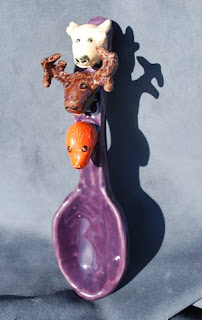
 H
Head down, hoody up - That's how some middle school students enter the art room on the first day of class. This is NOT where they want to be; what they want to be doing. Sleeping, music, texting, gaming, maybe even reading a good book are all preferable activities. Art class is scary, the potential for leakage of authentic self, great.
First day of school: I will station myself in the hallway, greet and smile, exchange a few hugs with returning students, try for eye contact with the newbies - so hard to reach into, beyond the lacquered shell of young teens. We'll get there, step by tiny step.
Backward portraits are a way to save face for this perpetually embarrassed age group. So is lots of choice within limits. "Freedom is moving easy in harness." I've always loved that quotation despite having to write a timed Senior Essay about it some 35 year ago....
Technology will help me increase options. Have a friend snap your own rear-view portrait and work from your phone or class iPad, or have a friend pose and create a portrait of someone else which feels safer....unless you have to pose.
But when it's all done and up, the pride and fun as we identify who's who, artist and model. After all, everyone likes a little positive attention, even if eye contact is still a challenge.
 Contemplating impending retirement, I revisit works of art created by so many students over the years. What a complete joy and privilege to nurture and witness creativity unfolding. Even after all these years, I wonder at the creative process. It is a dance, the partners, freedom and restriction, taking turns leading the steps, sometimes in sync, sometimes out of step completely. Art projects, in a classroom environment, are like problem sets for critical thinking. The teacher's role is to pose a question, provide some tools and skills, then step back and let it all happen. MUCH easier said than done, to be sure! My favorite admonishment to students, given after project instructions and usually with a wink: "Rules (in the art room) are meant to be broken."
Contemplating impending retirement, I revisit works of art created by so many students over the years. What a complete joy and privilege to nurture and witness creativity unfolding. Even after all these years, I wonder at the creative process. It is a dance, the partners, freedom and restriction, taking turns leading the steps, sometimes in sync, sometimes out of step completely. Art projects, in a classroom environment, are like problem sets for critical thinking. The teacher's role is to pose a question, provide some tools and skills, then step back and let it all happen. MUCH easier said than done, to be sure! My favorite admonishment to students, given after project instructions and usually with a wink: "Rules (in the art room) are meant to be broken."  Over the years, I have discovered that the richest creative moments and art experiences both in the classroom and in my own studio occur when rules are broken either accidentally or intentionally. Nurturing the capacity for students to create, follow and BREAK their own rules is true teaching, far more an art than a science.
Over the years, I have discovered that the richest creative moments and art experiences both in the classroom and in my own studio occur when rules are broken either accidentally or intentionally. Nurturing the capacity for students to create, follow and BREAK their own rules is true teaching, far more an art than a science.


























